Documentary : Traditional Culture
![]()
Home to the Finest Craftsmen
DC271434![]()
手わざ恋々和美巡り [BS4]
![]()
![]()
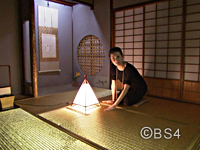

|Length : 54min. |Year : 2014 |
Join actress Rei Dan on a visit to Kanazawa, in the ancient Japanese domain of Kaga. Rei looks into the amazing story of gold leaf craftsmanship here that dates back to the 17th century. Find out how Kanazawa became a center of the arts and culture and how many of those arts and crafts live on to this day. Luckily, Kanazawa was saved from much of the damage the country suffered during the last war and as a result much of the old town and residences still stand as they did when they were first built. Rei also visits various craftsmen and women to see how gold leafing has evolved and adapted to the changing times.
Kenka Tanabata : The Float Fighting Festival of Kesencho
DC271233![]()
日本の祭り「ぶつけろ、魂!力の限り!!」 [TVI]
![]()
![]()
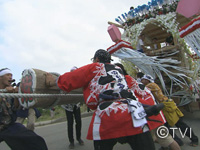
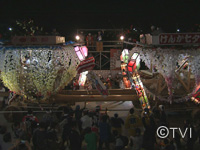
|Length : 48min. |Year : 2012 |
Imaizumi Ward, Kesencho, Rikuzen-Takata, Iwate Prefecture, Japan was a historic town that flourished since the Edo Period, and was home to some 2,000 residents in 550 households. Since the days of old, the connections between houses had been strong, and the town still retained the feel of a collective village community.
Kenka Tanabata, the Float Fighting Festival, has been a tradition here for over 900 years. Four groups from neighboring towns each made their own gorgeously decorated floats, then crashed them together full force in this 'rough and tumble' festival. For the locals it was the most important event of the year, with the townsmen preparing months in advance. People young and old looked forward to the festivities.
Then, on March 11, 2011, the Tohoku earthquake shook the region. A tidal wave over 10 meters high engulfed the town, destroying 99% of the homes. 230 people, some 10% of the local population, lost their lives. Where houses once stood in Imaizumi Ward, now is an empty wasteland. Former residents are now separated, relocated to various temporary housing complexes in outlying towns.
However, despite their daily struggle just to get by after the disaster, the townsmen were determined that the festival be continued. They feared that if the festival were discontinued, the people who had once lived here would forever lose their local spirit.
It will take at least 5 years to lay the groundwork for people to be able to live in the Imaizumi area again. For Imaizumi, the festival is the only remaining emblem of the town now razed to the ground; "Until people can come back and live here again..." On August 7th, 2012, at the site of the former main street, the townsmen recommenced the Kenka Tanabata Festival. They wanted to show everyone how not to give up.
Murone Shrine Grand Festival
DC271032![]()
守り続けて1300年 みちのくの荒祭り [KHB]
![]()
![]()
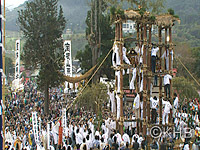
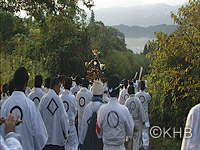
|Length : 30min. |Year : 2010 |
Murone Shrine was built in Mutsu Province (now Ichinoseki city in Iwate prefecture) when they re-enshrined a god, Kumano-no-kami, of the Kii Province during the Nara period, to pray for their success in conquering Ezo, or present day Hokkaido. This program captures the festival which is held to welcome the god. People who run the festival are called "Jin-yaku," and their role is passed down through the generations of families who can trace their lineage to the people who moved from the Province of Kii 1300 years ago. The highlight of this 3-day festival is the "Matsuriba event," held in the early morning on the third day. In complete darkness, two mikoshi, or portable shrines, are carried out and raced down the steep slope of a mountain. The race continues until the portable shrines are elevated and settled in their temporary location at the foot of the mountain. This program introduces the entire festival, while capturing the challenges of the people who face having to pass down these rituals to the next generation.
Kyoto : A Tale of Ancient Gardens – Part 2
DC270930![]()
京都・庭の物語 ~千年の古都が育んだ空間美~ (後編) [NHK]
![]()
![]()

|Length : 40min. |Year : 2009 |
During the 1,200 years since Kyoto became the capital of Japan, many of Japan's greatest gardens have been created there. The images of natural scenery they present are imbued with the traditional Japanese feelings of deep respect and awe for nature. This program introduces the attractions of the gardens at Daigoji, Shisendo and Tofukuji temples, as well as the Urasenke tea garden: moss-covered paths, stones and trees placed seemingly at random... Join us as we visit them and consider their designs that so vividly reflect their creators' intentions and delicate sense of beauty.
Kyoto : A Tale of Ancient Gardens – Part 1
DC270829![]()
京都・庭の物語 ~千年の古都が育んだ空間美~ (前編) [NHK]
![]()
![]()

|Length : 50min. |Year : 2008 |
Japanese gardens embody the Japanese aesthetic. This program introduces a number of Kyoto gardens including those of Kinkakuji, Ryoanji, Daikakuji, Byodoin, and Tenryuji. temples. Impressive high-definition images will show the changing faces of these seasonal gardens. Join us as we journey through these ancient gardens and delve into the profound meanings behind them. Discover how "dry gardens" retain the beauty of a simple stone and see how emperors, warlords, nobles, and priests all took part in the creation of these magnificent gardens.















